...
Blog categories
- Sweet recipes (95) click
- Salty recipes (8) click
- Cooking (27) click
- Seasonal recipe ideas (64) click
- Things to know (21) click
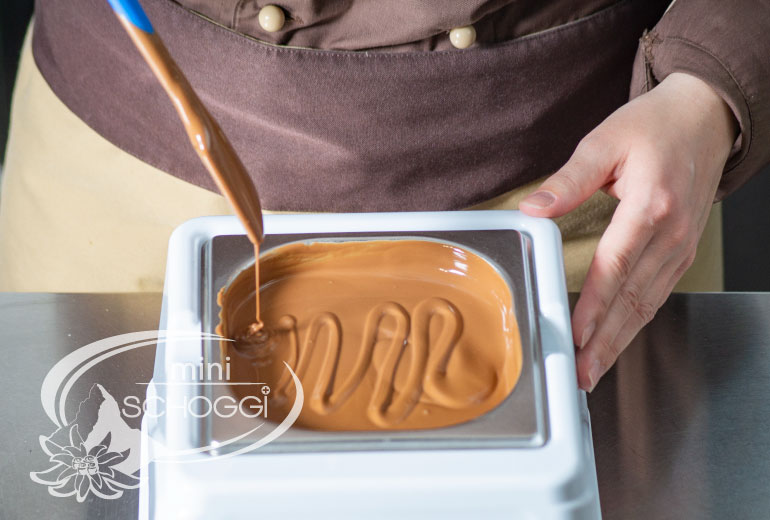
Tempering chocolate and couverture is essential if you want a nice, crisp and shiny end result. In this blog post, we will briefly explain the different tempering methods and show you their advantages and disadvantages. Would you like to learn the methods in more detail and acquire even more knowledge? Then definitely come to our couverture tempering course. There you will learn everything you need to know about the different couvertures and the tempering processes.
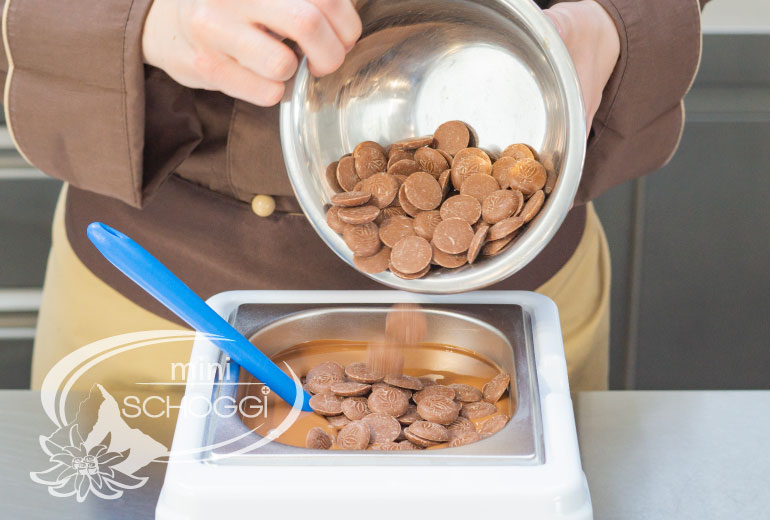
In this method, the stable crystals are added in drop form to the dissolved couverture.
Two thirds of the couverture drops are melted at 45 °C and inoculated with one third of already stable couverture drops (room temperature).
At a temperature of 45 °C, all stable and unstable fat crystal forms contained in the cocoa butter disappear. By cooling and adding couverture pieces that contain stable fat crystals, the melted couverture is allowed to form new stable fat crystal forms.
The couverture pieces dissolve in the couverture that is too warm and are evenly distributed throughout the couverture by regular stirring. This is why this method is called the inoculation method. The dissolved 45 °C warm couverture, which no longer contains stable fat crystals, is inoculated with stable crystals in the form of solid, cooler (room temperature) couverture pieces.
Please note that there are various methods for the tempering process, but we recommend the inoculation method, as it is undoubtedly the simplest and most frequently used method. For the inoculation method you do not necessarily need a tempering device, a bowl over a water bath is sufficient. However, it is much easier if a tempering device is available, which makes working comfortable and stress-free. After all, working with chocolate should be a lot of fun.
This method requires little cleaning.
Only little space is needed for the working process.
The inoculation method is the easiest to use.
Tempering in this way promises the greatest chance of success.
Once the couverture is inoculated, time does the rest. A permanent presence is not necessary, occasional stirring is enough to succeed.
Hardly any special material is needed.
It takes a while for all the couverture drops to melt.
It is imperative to have stable crystals in the form of couverture drops for inoculation. It is recommended to use the same type of couverture.
If you have no more couverture drops, the dissolved couverture cannot be inoculated and therefore the inoculation method cannot be used.
Only works with larger quantities of melted couverture (at least 300 g), if there is too little couverture, the added couverture pieces will not dissolve nicely.
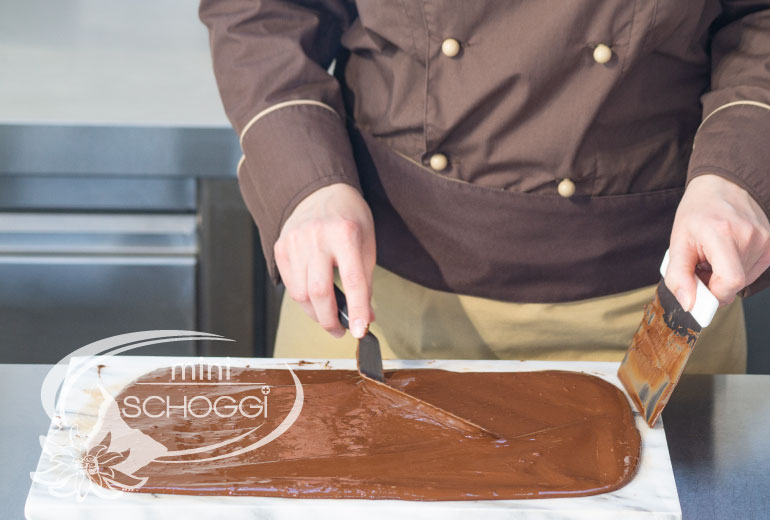
With this method, stable fat crystals are formed by cooling to 27 °C and moving on a cold surface.
With the tablature method, the whole couverture is heated to 42 °C. Half of the 42 °C warm couverture is emptied out on a cold work surface (marble or granite table / worktop). Now the 42 °C warm couverture is cooled down to 27 °C with the help of an angled spatula and a metal horn while continuously stroking back and forth. The cooled couverture is then returned to the bowl with the remaining 42 °C couverture and mixed well.
The stable fat crystals that have now formed are distributed throughout the couverture. The 42 °C warm couverture is cooled down very quickly to about 30 °C by adding the couverture that has cooled down to 27 °C. The couverture is then mixed well.
As soon as the couvertures are well mixed together, everything has to be warmed up a little more, depending on the case, to reach the optimal processing temperature.
This is undoubtedly the most elegant, but also the most cleaning-intensive method of tempering. With a little practice, it is a very quick variant and is also very suitable for smaller quantities or homemade bean-to-bar couvertures.
No additional couverture drops are needed for tempering.
This is the most elegant and sensual way to temper couverture.
Also works well with smaller amounts of melted couverture.
If the couverture is still a little too warm after the first tempering, it is easier and quicker to cool it down further with the tabling method than with the addition of drops.
There is a considerable cleaning effort.
A cool work surface (marble or granite table / worktop) is imperative.
Tabling is a complicated work process that can only be done safely with a little practice.
During the work process, no other activity can be carried out, so this method requires the highest presence time.
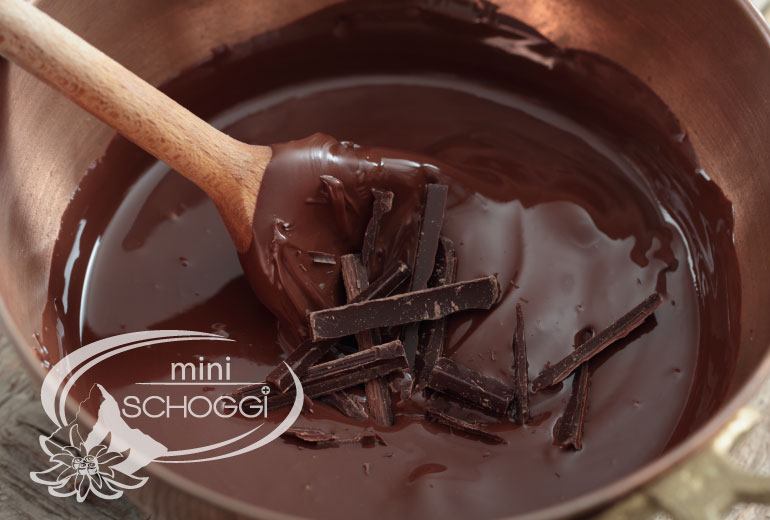
Well pre-crystallised couverture can also be heated directly (30 - 33 ºC, depending on the type of couverture). Make sure that the stable crystals are not completely dissolved.
This is certainly one of the most difficult methods of tempering couverture and is not recommended for beginners.
Place the couverture drops in a plastic bowl in the microwave several times for a short time (approx. 20 seconds) and mix the couverture well after each heating. Repeat until the desired processing temperature has been reached. This method is also not recommended for beginners, as the couverture can become too warm if it is in the microwave for just a few seconds too long.
By adding pre-tempered, freeze-dried cocoa butter, the finished crystals can be added to the liquid chocolate (34 ºC) and stirred in. The added cocoa butter then triggers the correct formation of the fat crystals and thus enables tempering. This relatively new method is used in a slightly modified form by the majority of the chocolate industry.
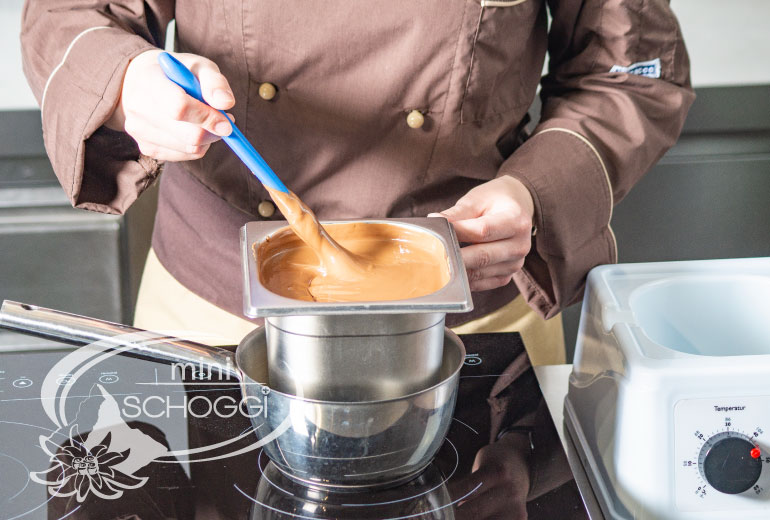
Put enough water in a large pan so that the bowl you want to use for the chocolate does not touch the water when you put it on the pan. Heat the water without the bowl. As soon as the water boils, turn the heat down to the second lowest setting.
Now pour 2/3 of the desired amount of couverture into the previously selected bowl and melt the couverture completely in it. We recommend that you use a stainless steel bowl, as this conducts the heat optimally and the couverture melts even faster.
Attention: Absolutely no moisture should get into the couverture. Furthermore, the temperature must never rise above 50 ºC, as the lactose begins to caramelise at too high a temperature and lumps form. This lump formation is irreversible and this couverture can no longer be used for pure chocolate products, because the caramel pieces remain even if the tempering process is repeated.
Once the couverture pieces have completely dissolved in the water bath (45 ºC), you must remove the bowl from the pan, add 1/3 of the couverture drops, stir well and leave the bowl like this for a short time. The drops will dissolve and cool down the total amount until the couverture becomes a little more solid or thick again.
When the couverture has reached a temperature of 26 - 28 ºC, you must heat it again over the water bath. Heat the couverture slowly so that it does not get too hot. It is better to bring the couverture to the final temperature in small stages than to heat it too quickly and possibly burn it. Don't forget that the bowl will continue to heat up a little for a short time, making the couverture inside about 1 - 2 ºC warmer. We therefore recommend that you remove the bowl with the couverture from the water bath a little early, just before the perfect final temperature, to avoid overheating the couverture. Reheat in small stages until the correct processing temperature is reached (30 - 33 ºC depending on the type of couverture).
All you need is a pan, a bowl and a thermometer.
This method is easy for anyone to make at home.
It is an inexpensive method of tempering couverture.
The couverture cannot be left alone.
Permanent supervision is necessary so that the couverture does not get too hot.
The water must not get into the couverture under any circumstances, otherwise it will clump together and only be suitable for baking.
Couverture or chocolate should never be heated or melted with direct heat. This means that you should never melt couverture directly in a pan on the cooker. If you want to melt chocolate or couverture, you should always do it over a water bath with indirect heat. Couverture and chocolate burn as soon as they reach a temperature of more than 50ºC. The lactose in the milk powder begins to caramelise and small "grains of sand" form. Unfortunately, these grains do not disappear again, not even by sieving or mixing. If you eat burnt couverture, the sandy texture is quickly recognisable and there is also a slightly bitter aftertaste. In this state, the couverture can no longer be used for pure chocolate products such as pralines, chocolate bars, fillings or figurines. However, you can still use a slightly burnt couverture to make a chocolate cake. In a cake, different ingredients come together and thus the sandy texture is no longer recognisable.
 Casting your own chocolate Easter bunnies
Casting your own chocolate Easter bunnies
 Make your own decor roulade
Make your own decor roulade
 Correctly temper couverture and chocolate
Correctly temper couverture and chocolate
 Cake Recipes Convert
Cake Recipes Convert
 Casting Father Christmas from chocolate
Casting Father Christmas from chocolate
Leave a comment